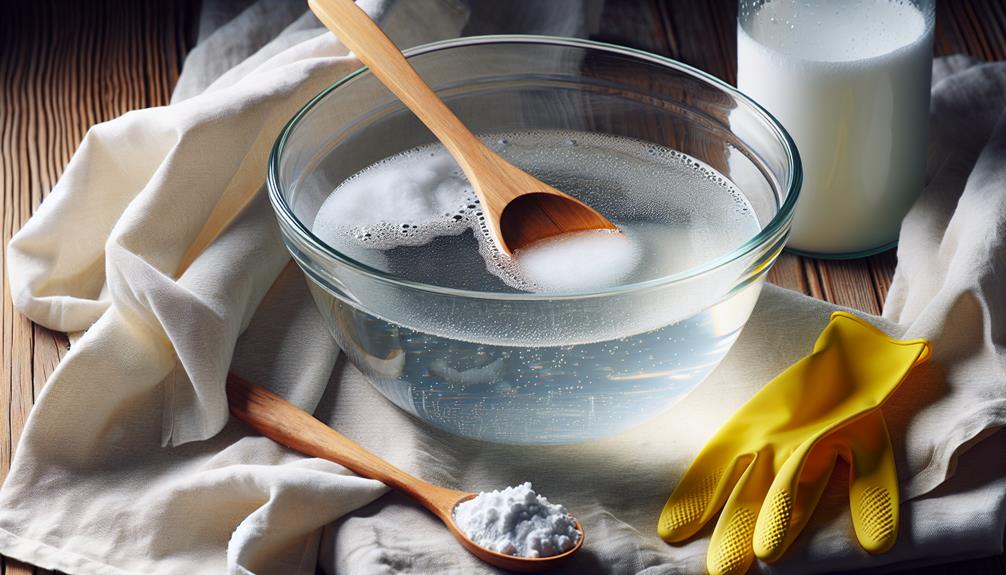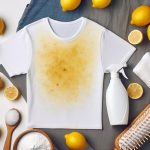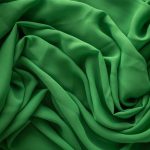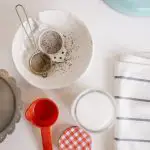As the saying goes, 'Where there's a will, there's a way.' When it comes to bleaching linen, finding the right method can make all the difference.
From natural remedies like vinegar and lemon juice to more specialized approaches such as oxygen bleach and potassium permanganate, the possibilities are vast.
But which method reigns supreme for achieving that pristine white linen look? Let's explore the pros and cons to uncover the ultimate solution for your bleaching needs.
Table of Contents
Key Takeaways
- Utilize natural bleaching agents like vinegar, baking soda, and sunlight for eco-friendly linen whitening.
- Follow safe handling practices with protective gear when using bleaching solutions like hydrogen peroxide.
- Incorporate effective whitening solutions such as oxygen bleach and aspirin for brightening and stain removal.
- Implement sustainable bleaching methods and techniques to maintain linen freshness and brightness.
Vinegar
Using white vinegar for bleaching linen is a natural and effective method that can brighten and disinfect fabrics. White vinegar, a common household item, is a versatile eco-friendly solution for tackling stains and yellowing on linen fabrics. Its acidity helps to break down residue and lift stains without the need for harsh chemicals, making it a gentle yet powerful option for whitening linens.
When dealing with stained or yellowed white linen items, creating a solution of white vinegar and water can work wonders. This mixture can be used for soaking or spot-treating affected areas before washing. Additionally, adding white vinegar to the washing machine along with your regular detergent can enhance the bleaching process, resulting in brighter and fresher linens.
Baking Soda
I've found that using baking soda is a fantastic way to tackle stains and naturally bleach linen. Not only does it brighten whites and remove odors, but it also helps soften the fabric.
Stain Removal Tips
When dealing with stains on linen, incorporating baking soda as a natural remedy proves to be a highly effective solution due to its abrasive and absorbent properties. Baking soda, a natural stain remover, can effectively lift stains, odors, and residue from white linen without the need for harsh chemicals.
By creating a paste with water, baking soda can be used to pre-treat stains on linen before washing, ensuring a thorough cleaning process. Its gentle nature makes it safe for regular stain removal on white linen garments, while its alkaline properties aid in breaking down stains and brightening the fabric.
For those seeking a simple and natural solution for stain removal on linen, baking soda is a reliable choice.
Natural Bleaching Methods
To further enhance the cleaning power of baking soda on linen, exploring its natural bleaching properties can be a game-changer in maintaining the fabric's pristine white appearance. Baking soda serves as a gentle and eco-friendly option for whitening linen without the use of harsh chemicals.
Its natural bleaching capabilities help eliminate stains, odors, and yellowing from white linen effectively. By creating a paste with water, baking soda can target specific spots on linen for treatment. Additionally, incorporating baking soda into the laundry cycle can further boost its whitening effects on linen garments.
Embracing baking soda as a natural bleaching method not only ensures a brighter white for your linen but also promotes a more sustainable and environmentally friendly approach to fabric care.
Oxygen Bleach
Oxygen bleach, a powerful and eco-friendly alternative to chlorine bleach, offers a safe and effective method for whitening linen garments. Here are three key points to understand its effectiveness:
- Non-toxic Alternative: Oxygen bleach, like sodium percarbonate, serves as a chlorine bleach alternative for whitening linen. It's gentle on fabrics while still effectively removing stains and brightening the material.
- Eco-Friendly Solution: Unlike chlorine bleach, oxygen bleach is chlorine-free and environmentally friendly. It provides a safe way to brighten fabrics without harmful chemicals, making it a suitable choice for those looking to reduce their environmental impact.
- Enhanced Whitening: By adding 1-2 tablespoons of oxygen bleach to the washing machine, you can enhance the whitening process for your linen garments. This method not only helps maintain the white color of linen but also ensures the fabric remains undamaged throughout the cleaning process.
Sunlight
Harnessing the natural power of sunlight is a simple and effective method for bleaching linen garments. Sunlight naturally bleaches linen when garments are air-dried outdoors.
Not only is this a cost-effective way to whiten linen, but it can also help remove odors that may be lingering in the fabric. Additionally, sun-drying linen can brighten colors and is environmentally friendly.
To ensure even bleaching, remember to turn your linen garments while drying in the sunlight. This gentle and natural method is a great way to whiten linen fabrics without the use of harsh chemicals.
Sunlight not only helps in whitening but also aids in maintaining the freshness of your linen items. So, next time you want to brighten up your linens, consider harnessing the power of sunlight for a natural and effective bleaching process.
Lemon Juice
Lemon juice's natural citric acid presents a powerful bleaching agent ideal for whitening linen garments effectively. When using lemon juice to bleach linen, consider the following:
- Create a Solution: Mix lemon juice with water to create a solution suitable for soaking linen garments. This mixture helps remove stains and brighten the fabric due to the natural bleaching properties of citric acid.
- Pre-Treat Stains: Apply lemon juice directly to stains before washing to pre-treat and enhance the bleaching process. The acidity of lemon juice aids in breaking down stains and discoloration on linen effectively.
- Eco-Friendly Alternative: Opting for lemon juice as a bleaching agent isn't only effective but also eco-friendly. It offers a safe alternative to chemical bleaches, making it a sustainable choice for whitening linen while being mindful of the environment.
Hydrogen Peroxide
To effectively whiten yellowed white linen fabric, hydrogen peroxide serves as a suitable alternative to traditional bleach. It can be a gentler option for brightening linen items without the harsh effects of chlorine bleach.
Adding hydrogen peroxide to the laundry detergent dispenser and using it in a wash cycle can help restore the white color of linen garments. Care label instructions for water temperature should be followed when using hydrogen peroxide to bleach linen, ensuring optimal results.
Additionally, combining hydrogen peroxide with other natural bleaching agents like lemon juice can enhance the whitening effect on linen fabric, providing a more thorough cleaning process.
This alternative method offers a safer and eco-friendly approach to brightening yellowed white linen, giving you the satisfaction of pristine, refreshed linens without the potential damage of harsh chemicals.
Laundry Blueing
Adding laundry bluing to the final rinse cycle of washing white fabrics can effectively counteract yellowing and create an optical illusion of whiteness. Laundry bluing works wonders in enhancing the brightness and cleanliness of white linens.
Here are three key points to keep in mind when using laundry bluing:
- Neutralizing Yellow Tones: Laundry bluing helps neutralize yellow or gray tones in white fabrics, making them appear whiter and fresher.
- Optical Illusion of Whiteness: The blue dye in laundry bluing reflects light differently, creating an optical illusion that reduces the appearance of yellow or dingy hues in the fabric.
- Application in Final Rinse Cycle: For optimal results, add laundry bluing to the final rinse cycle of washing. This allows the blue tint to work its magic on the fabric, enhancing its whiteness effectively.
Ammonia and Water
I'm ready to talk about ammonia and water for bleaching linen. Mixing these two creates a powerful bleaching solution that can effectively whiten yellowed fabrics.
Before we get into the details, it's important to understand the proper ammonia dilution ratios and safety precautions for handling this solution.
Ammonia Dilution Ratios
When diluting ammonia for bleaching linen, mix 1/4 cup of ammonia with 1 gallon of water for optimal results. Here are three key points to consider when working with ammonia dilution ratios:
- Yellowed Linen Garments: The 1/4 cup of ammonia to 1 gallon of water mixture is effective for soaking yellowed linen garments, helping to restore their brightness.
- Whitening Fabrics: Ammonia and water have long been trusted for their ability to whiten fabrics gently yet effectively, making them ideal for treating linen.
- Thorough Rinsing: After using the ammonia solution, it's crucial to follow up with thorough rinsing and washing to ensure all residues are removed, leaving the linen fresh and clean.
Safety Precautions for Handling
To handle ammonia and water safely when bleaching linen, it is crucial to work in a well-ventilated area and wear protective gloves to prevent exposure to fumes and chemicals. Proper precautions are essential to avoid any potential harm. Here are some safety measures to follow:
| Safety Precautions | Description |
|---|---|
| Wear Protective Gloves | Prevents direct contact with ammonia and water, safeguarding your skin. |
| Work in Ventilated Area | Minimizes inhalation of fumes by ensuring proper airflow during the process. |
| Thoroughly Rinse Linen | After bleaching, rinse the linen garments adequately to remove chemicals. |
| Proper Disposal | Dispose of any leftover ammonia and water mixture safely to prevent accidents. |
Aspirin
Dissolving aspirin in water creates a mild bleaching solution that can effectively whiten linen fabric. Aspirin's bleaching properties make it a safe alternative to harsh chemical bleaches for whitening linen garments.
Here are three key points to consider when using aspirin as a bleaching solution for linen:
- Gentle Whitening: Aspirin, with its acetylsalicylic acid, can gently break down stains and discoloration on linen fabric without causing damage. This makes it a suitable option for delicate or yellowed linens.
- Safe Alternative: Compared to strong chemical bleaches, aspirin offers a milder approach to whitening linen. It's less likely to cause fabric deterioration, making it a preferred choice for those looking to preserve the quality of their linen items.
- Effective Stain Removal: When dissolved in water, aspirin can effectively target and remove stubborn stains on linen, restoring its original white color. This method is particularly useful for treating localized stains on linen garments.
Potassium Permanganate
How can potassium permanganate effectively bleach light-colored linen garments while ensuring safety and optimal results?
Potassium permanganate is a potent bleaching agent specifically designed for light-colored linen fabrics. This chemical can be easily obtained from pharmacies or gardening shops for the purpose of bleaching. When preparing a solution with potassium permanganate, it's crucial to follow specific application techniques to achieve the desired results effectively.
One of the primary benefits of using potassium permanganate is its ability to neutralize yellowing in linen, restoring the fabric to its original brightness.
However, it's essential to note that working with potassium permanganate requires strict adherence to safety measures. Proper preparation of the solution and adequate ventilation are crucial aspects to consider when bleaching linen with this chemical. By ensuring these precautions are in place, you can effectively utilize potassium permanganate as a bleaching agent for your light-colored linen garments while maintaining a safe environment for yourself and others.
Whiten With Hydrogen Peroxide
I've discovered that using hydrogen peroxide to whiten linen can be a game-changer. The peroxide bleaching method is simple – just add it to the laundry detergent dispenser and run a wash cycle.
However, it's crucial to follow safety precautions and care label instructions on water temperature when using hydrogen peroxide for bleaching linen.
Peroxide Bleaching Method
Regularly using hydrogen peroxide in the wash cycle can effectively whiten yellowed white linen fabrics. When employing this bleach alternative, it's essential to follow specific steps to ensure optimal results:
- Utilize the Laundry Detergent Dispenser: Add hydrogen peroxide to the designated compartment in the dispenser for even distribution.
- Mind the Water Temperature: Adhere to the care label instructions regarding water temperature to prevent damage to the linen fibers.
- Safe and Effective Method: Hydrogen peroxide is a safe and efficient way to remove stains and yellowing from linen garments.
Application on Linen
To effectively brighten yellowed white linen, utilizing hydrogen peroxide in the laundry detergent dispenser during a wash cycle proves to be a reliable method. This approach offers an alternative to traditional bleach for whitening linen items effectively.
By adding hydrogen peroxide to the laundry routine, you can achieve a refreshed and brightened look for your linens. It's essential to follow safety guidelines and the manufacturer's recommendations when using hydrogen peroxide on linen. Prioritize testing a small, inconspicuous area of the fabric before treating the entire garment to ensure compatibility.
For enhanced bleaching effectiveness, consider combining hydrogen peroxide with other whitening agents like baking soda. This method can help you maintain the pristine white appearance of your linen items.
Safety Precautions Required
For safe and effective linen bleaching with hydrogen peroxide, always adhere to the care label instructions for water temperature to prevent fabric damage. When working with hydrogen peroxide to bleach linen, it's essential to take specific safety precautions to ensure successful results and maintain the quality of the fabric.
Here are three crucial safety measures to consider:
- Test Compatibility: Before applying hydrogen peroxide to the entire fabric, test a small, inconspicuous area to check for any adverse reactions or damage.
- Proper Dilution: Dilute hydrogen peroxide with water as recommended to prevent potential fabric discoloration or harm during the bleaching process.
- Thorough Rinsing: After bleaching, make sure to rinse and wash the linen items thoroughly to remove any residues and safeguard the fabric's integrity.
Using Oxygen Bleach
Using oxygen bleach in your laundry routine can enhance the brightness of your linens while being environmentally friendly. Oxygen bleach, like sodium percarbonate, is an eco-friendly and non-toxic alternative for whitening your linen garments. It works effectively to remove stains and kill bacteria when added to the wash cycle.
Being chlorine-free, oxygen bleach is safe for the environment and suitable for both household cleaning and fabric bleaching. For optimal results, it's recommended to use 1-2 tablespoons of oxygen bleach per load. This type of bleach is known for its ability to whiten fabrics without causing harm to the environment, making it a popular choice for those looking for a greener laundry solution.
Frequently Asked Questions
Can Linen Fabric Be Bleached?
Yes, linen fabric can be bleached using various natural and chemical agents like white vinegar, lemon juice, and hydrogen peroxide. Oxygen-based alternatives, such as sodium percarbonate, are effective too. Sunlight bleaching is eco-friendly.
How Do You Evenly Bleach Linen?
To evenly bleach linen, I ensure thorough soaking in the bleach solution, rotating and agitating the fabric periodically. I handle the linen gently to prevent damage and follow recommended soaking times for optimal results. After bleaching, rinse thoroughly to remove residual bleach.
How Long to Soak Linens in Bleach?
I adjust soaking times for linens in bleach based on how much whitening is needed and the fabric's color. Longer soaks, up to an hour, work for heavily stained linens. Rinse well after to prevent damage.
How Do You Fade Linen Fabric?
To fade linen fabric, I recommend utilizing gentle methods like sunlight exposure or oxygen bleach. Avoid harsh chemicals like chlorine bleach, which can damage the fabric. Always test on a small area first.
- Tetron Fabric 36: Specifications and Uses - June 17, 2025
- Tetron Fabric Manufacturers in India: Who to Contact - June 17, 2025
- Tetron Fabric Suppliers in Delhi: A Detailed List - June 17, 2025






